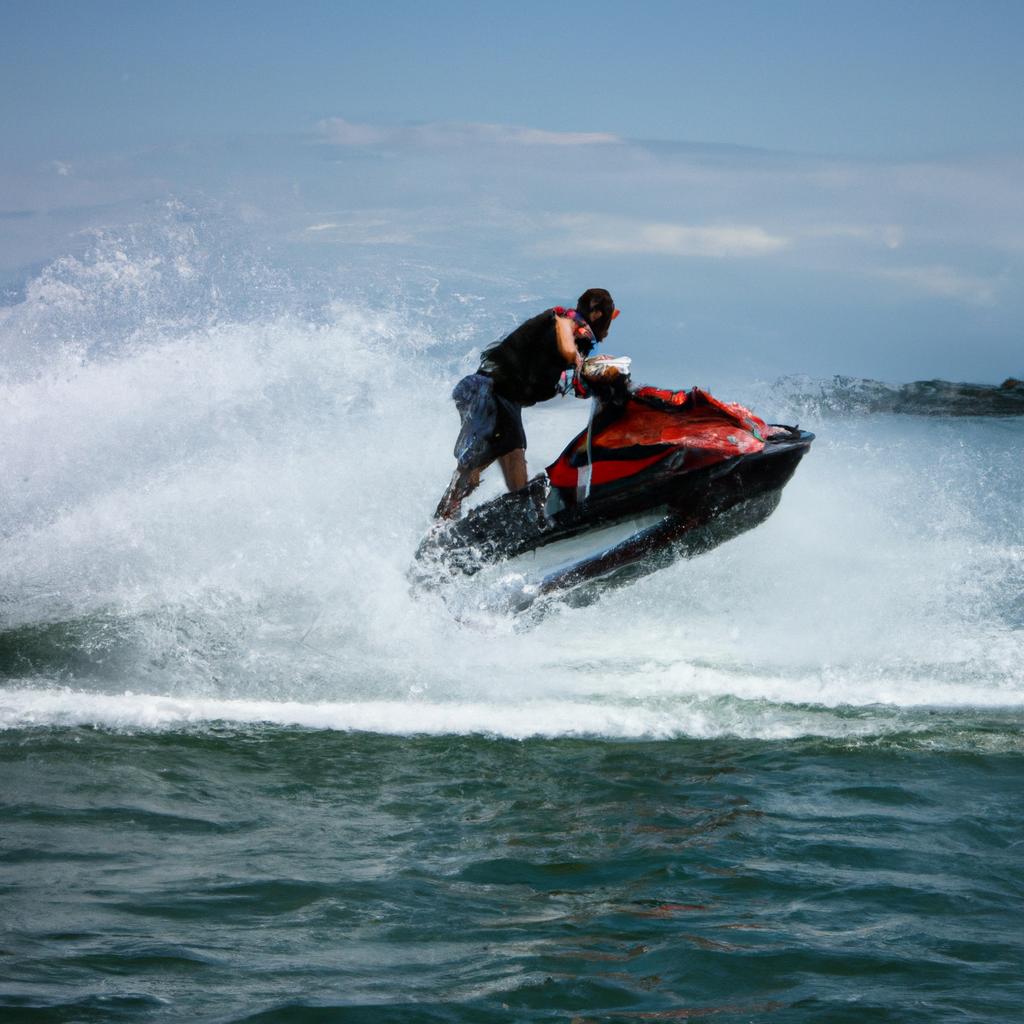Jet Ski Tricks: Mastering the Ultimate Water Sport Skills

Jet Ski Tricks: Mastering the Ultimate Water Sport Skills
The exhilarating world of jet skiing offers individuals a thrilling experience on the water, combining speed, agility, and adrenaline. For those seeking to take their jet ski adventures to new heights, mastering various tricks is essential. This article delves into the realm of jet ski tricks, exploring the techniques and skills required for riders to perform gravity-defying stunts with finesse.
To illustrate the potential mastery of these water sport skills, let us consider an example. Imagine a professional jet skier named Alex who has spent years honing their abilities on the waves. With precise control over their machine and impeccable timing, Alex executes flawless backflips in mid-air while maintaining perfect balance upon landing. Such a feat requires not only physical dexterity but also mental focus and strategic planning. By unraveling the secrets behind such awe-inspiring maneuvers, this article will guide aspiring riders towards becoming masters of their craft in the world of jet ski trickery.
Getting Started: Essential Equipment for Jet Ski Tricks
To embark on the thrilling world of jet ski tricks, it is essential to have the right equipment. Without proper gear, attempting even basic maneuvers can be dangerous and ineffective. This section will outline the key elements you need to get started on your journey towards mastering this exhilarating water sport.
Imagine yourself cruising through the waves, ready to show off your skills with a powerful jet ski at your command. Before diving into the excitement, however, it is crucial to ensure that you are equipped with everything necessary for a safe and successful experience.
Essential Equipment Checklist:
- Life Jacket: A properly fitted life jacket is mandatory when engaging in any water activity. It provides buoyancy and ensures safety by keeping you afloat in case of an accident or unexpected fall.
- Helmet: Protecting your head during high-speed stunts is paramount. Wearing a helmet designed specifically for jet skiing helps minimize the risk of head injuries and safeguards against potential collisions.
- Wetsuit: As you navigate through various tricks, splashes from the waves are inevitable. Investing in a wetsuit not only keeps you warm but also offers protection against abrasions caused by constant contact with water.
- Goggles: Clear vision is imperative while performing intricate maneuvers on a jet ski. Goggles shield your eyes from water splashes, wind gusts, and debris floating on the surface, ensuring optimal visibility throughout your ride.
| Item | Purpose | Importance |
|---|---|---|
| Life Jacket | Ensures personal safety | Essential |
| Helmet | Provides head protection | Crucial |
| Wetsuit | Offers warmth and protects against abrasions | Recommended |
| Goggles | Enhances visibility and shields eyes from external distractions | Important |
Equipped with these essentials, you now possess the foundation necessary to begin your jet ski trick journey. By mastering these fundamental skills, you will be ready to take on more challenging tricks with confidence and finesse.
Perfecting Your Balance: Tips for Maintaining Stability on a Jet Ski
Transitioning smoothly from the previous section, where we discussed the essential equipment for jet ski tricks, let us now delve into an equally important aspect of mastering this exhilarating water sport: maintaining stability on a jet ski. Imagine you are out on the open water, attempting to execute impressive tricks with precision and grace. To achieve this level of skill, it is crucial to understand how to perfect your balance and stability. Let’s explore some valuable tips that will help you stay steady and in control as you navigate the waves.
Imagine a scenario where you’re performing a daring trick called “The Backflip.” As you soar through the air, it becomes evident just how vital balance is in executing such maneuvers flawlessly. To enhance your stability on a jet ski, consider implementing the following strategies:
- Proper body positioning: Maintain a centered posture while riding by keeping your knees slightly bent and distributing your weight evenly between both feet.
- Core strength exercises: Engage in regular workouts that target your core muscles to improve overall stability and control.
- Grip technique: Master gripping techniques that provide maximum contact between your hands and the handlebars, ensuring better steering ability.
- Practice makes perfect: Regularly spend time honing your skills on calm waters before progressing to more challenging environments.
To further illustrate these points visually, let’s take a look at a table highlighting four key elements for maintaining stability on a jet ski:
| Key Elements | Description |
|---|---|
| Body Positioning | Keep knees slightly bent and distribute weight evenly |
| Core Strength Exercises | Strengthen core muscles for improved stability |
| Grip Technique | Master hand-handlebar grip methods for optimal control |
| Consistent Practice | Regularly practice in controlled environments |
By incorporating these recommended steps into your training routine, you can enhance your balance and maintain greater control over your jet ski during high-speed maneuvers or complex tricks.
Moving forward, our next section will focus on mastering basic maneuvers such as turning, accelerating, and stopping. Understanding these fundamental skills will lay a solid foundation for executing more advanced tricks in the future. So let’s dive into the world of maneuvering techniques without delay.
Mastering Basic Maneuvers: Turning, Accelerating, and Stopping
Building upon your ability to maintain stability on a jet ski, let’s now explore the fundamental maneuvers that will help you navigate the water with confidence. By mastering basic techniques such as turning, accelerating, and stopping, you’ll be well-equipped for an exhilarating jet ski experience.
To illustrate the importance of these skills, consider a hypothetical scenario where you find yourself approaching a sharp turn while cruising at high speed. Without proper maneuvering techniques, maintaining control can become challenging. However, by learning how to execute precise turns, accelerate effectively when needed, and stop swiftly in emergency situations, you can confidently handle any obstacle that comes your way.
Turning:
- To initiate a turn smoothly and safely, lean into the direction you want to go while applying gentle pressure on the handlebars.
- As you approach the desired angle of turn, gradually release the throttle to reduce speed without losing balance.
- Maintain a firm grip on the handlebars throughout the entire turning process to ensure optimal control and stability.
- Practice different types of turns (e.g., wide arcs or tight turns) to enhance your overall maneuverability and adaptability on various terrains.
Accelerating:
- When accelerating from either a stationary position or after slowing down during a turn, evenly apply throttle while shifting your weight forward slightly.
- Distribute your body weight between both feet evenly to maintain equilibrium as you increase speed.
- Keep your eyes focused ahead rather than fixated on the water beneath you; this will help improve balance and prevent disorientation.
- Gradually increase acceleration instead of abruptly pushing the throttle forward to avoid sudden jerks that may compromise stability.
Stopping:
- To bring your jet ski to a halt quickly but safely, release the throttle completely while simultaneously squeezing both brakes firmly.
- Shift your weight backward slightly during braking actions to counterbalance any potential loss of momentum.
- Keep your knees slightly bent and maintain a firm grip on the handlebars to absorb any impact during sudden stops.
- Practice emergency braking maneuvers in controlled environments to enhance your reflexes and ability to react swiftly when needed.
By mastering these basic maneuvers, you’ll be well-prepared to take on more advanced jet ski tricks and techniques. In the subsequent section, we will delve into the thrilling world of advanced maneuvers that will push your skills further while ensuring an unforgettable experience on the water. So let’s gear up and explore the next level of excitement!
Building upon your mastery of basic maneuvering techniques, it’s time to elevate your skillset even further as we venture into the realm of advanced jet ski tricks and techniques.
Taking it to the Next Level: Advanced Jet Ski Tricks and Techniques
Transition Phrase: Building on the foundation of mastering basic maneuvers, we now delve into the exhilarating realm of advanced jet ski tricks and techniques.
To illustrate the potential excitement that lies ahead, let’s consider a hypothetical scenario involving a skilled rider named Jake. After months of honing his skills in turning, accelerating, and stopping, Jake is ready to push his limits further by attempting more daring maneuvers on his jet ski.
In order to excel at advanced jet ski tricks, riders must possess not only technical proficiency but also an understanding of key principles and strategies. Here are some essential tips to help you unlock your full potential:
- Maintain proper body position: To execute complex tricks effectively, maintaining balance and stability is crucial. Keeping your weight centered over the handlebars allows for better control while performing aerial stunts or tight turns.
- Utilize wave dynamics: Harnessing the power of waves can enhance your trick repertoire. By studying wave patterns and timing your moves accordingly, you can add flair to jumps or incorporate wave-driven spins into your routines.
- Experiment with throttle control: Adjusting throttle input during different phases of a trick can significantly impact its execution. Learning how to modulate speed seamlessly enables smoother transitions between maneuvers and opens up possibilities for unique combinations.
- Embrace creativity: Don’t be afraid to think outside the box when developing new tricks. Combining elements from various disciplines such as wakeboarding or freestyle motocross can lead to groundbreaking innovations in jet ski performance.
Now that we’ve explored some valuable insights into advancing your skill set, our next section will focus on safety precautions and guidelines that should always accompany these thrilling endeavors. Remember, pushing boundaries requires responsibility.
Table (markdown format):
| Skill | Description | Tips |
|---|---|---|
| Aerial Stunts | Executing flips or spins mid-air | Begin with smaller jumps to gain confidence and gradually increase height |
| Power Slides | Drifting sideways while maintaining control | Practice on calm waters before attempting in more challenging conditions |
| Tail Riding | Balancing on the back of the jet ski | Start with slow speeds and progress as your balance improves |
| Barrel Rolls | Rotating around the longitudinal axis of the watercraft | Master basic tricks involving rotation before attempting barrel rolls |
As we explore advanced techniques further, it is essential to prioritize safety. In our next section, we will discuss important precautions and guidelines for performing jet ski tricks.
(End of Section)
Safety First: Important Precautions and Guidelines for Jet Ski Tricks
Building upon the foundation of basic jet ski tricks, let us now delve into advanced techniques that will take your water sport skills to new heights. By mastering these next-level maneuvers, you’ll be able to showcase your prowess on the water and captivate audiences with awe-inspiring stunts.
To illustrate the potential for pushing boundaries in jet skiing, consider a hypothetical scenario involving an experienced rider named Sarah. With years of practice under her belt, Sarah has honed her skills and is eager to explore more complex maneuvers. One such technique she aims to master is the backflip – a thrilling aerial trick that requires precise timing and impeccable control over the craft.
Expanding our repertoire beyond traditional paragraphs, let’s utilize a bullet point list below to highlight four essential elements crucial for executing advanced jet ski tricks:
- Body Positioning: Maintaining balance while performing intricate moves is pivotal. Proper body positioning not only enhances stability but also allows riders to execute tricks smoothly.
- Throttle Control: Controlling the throttle with finesse enables riders to maintain optimal speed throughout various maneuvers. Adjusting the power output at different stages of a trick can greatly impact its success.
- Timing and Coordination: Perfectly timing each action while coordinating movements between body and machine ensures seamless execution of even the most challenging tricks.
- Practice and Persistence: Mastering advanced tricks demands dedication. Regular practice coupled with persistence helps riders refine their techniques, gradually increasing confidence levels.
Now, let’s incorporate a table that showcases some commonly performed advanced jet ski tricks along with their difficulty level (rated from 1 – easiest to 5 – most difficult) and corresponding thrill factor (rated from 1 – least thrilling to 5 – most thrilling):
| Trick | Difficulty Level | Thrill Factor |
|---|---|---|
| Backflip | 4 | 5 |
| Barrel Roll | 3 | 4 |
| Superman | 2 | 3 |
| Hydroplane Turn | 3 | 4 |
In conclusion, the realm of advanced jet ski tricks offers immense potential for those seeking to push their limits on the water. By mastering techniques such as the backflip and exploring a range of other exhilarating maneuvers, riders like Sarah can captivate audiences with their daring feats.
Transition into subsequent section: As you strive to push your boundaries and reach new heights in jet skiing, it becomes crucial to explore ways to continuously progress in this thrilling sport. Let us now delve into how you can keep challenging yourself while expanding your skill set even further.
Pushing Your Limits: How to Progress and Challenge Yourself in Jet Skiing
Transitioning smoothly from the previous section on safety precautions and guidelines, let us now delve into the exciting world of pushing your limits in jet skiing. Imagine this scenario: you have mastered the basic tricks and techniques, feeling confident in your abilities to perform various maneuvers effortlessly. Now is the time to take it up a notch and challenge yourself further.
To progress and truly excel in jet skiing, it is crucial to continuously push your limits while maintaining a strong focus on safety. By gradually increasing the difficulty level of your tricks, you can enhance your skills without compromising your well-being or that of others around you.
One way to do this is by incorporating more complex aerial stunts into your routine. Experiment with flips or spins while airborne, taking inspiration from professional freestyle riders who showcase their creativity during competitions. However, always bear in mind that attempting advanced tricks should only be done once you have gained sufficient experience and confidence in executing simpler ones.
In addition to advancing trick difficulty levels, expanding your knowledge about different types of waves can greatly contribute to mastering jet ski tricks. Familiarize yourself with wave characteristics such as height, speed, shape, and direction so that you can adapt your riding style accordingly. This understanding will enable you to choose suitable locations for practicing specific tricks as well as improve overall control over your craft.
As mentioned earlier, safety remains paramount throughout any progression journey. To help illustrate its significance effectively, consider these emotional reminders:
- The thrilling rush when successfully landing a backflip after months of practice
- The exhilarating sense of accomplishment upon conquering new challenges
- The relief felt knowing that proper protective gear prevented serious injuries
- The joy shared among fellow enthusiasts when witnessing remarkable displays of skill
To bring forth additional insights regarding safety precautions and guidelines within the context of progressing one’s skills in jet ski tricks, refer to the following table:
| Safety Measure | Importance |
|---|---|
| Wearing a life jacket | High |
| Using lanyard kill switch | Medium |
| Performing regular maintenance checks on the jet ski | Medium-high |
| Observing weather conditions before riding | High |
By incorporating these safety measures into your routine, you can ensure an enjoyable and secure experience as you push yourself further in mastering the ultimate water sport skills.
In summary, progressing in jet skiing involves gradually increasing trick difficulty levels while maintaining a strong focus on safety. By expanding your repertoire of tricks and understanding wave characteristics, you can enhance your overall performance. Remember to prioritize safety at all times by wearing proper protective gear and adhering to important guidelines. With dedication and practice, you will be able to reach new heights in the exhilarating world of jet ski tricks.







